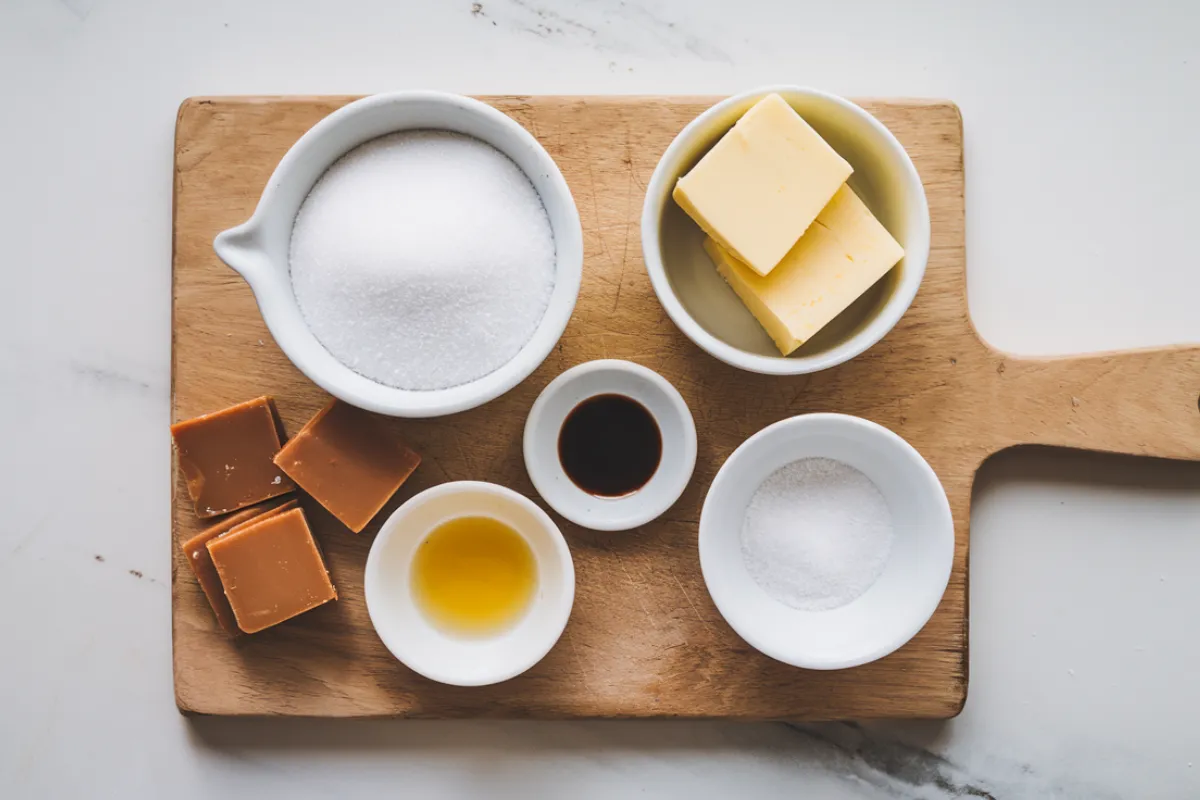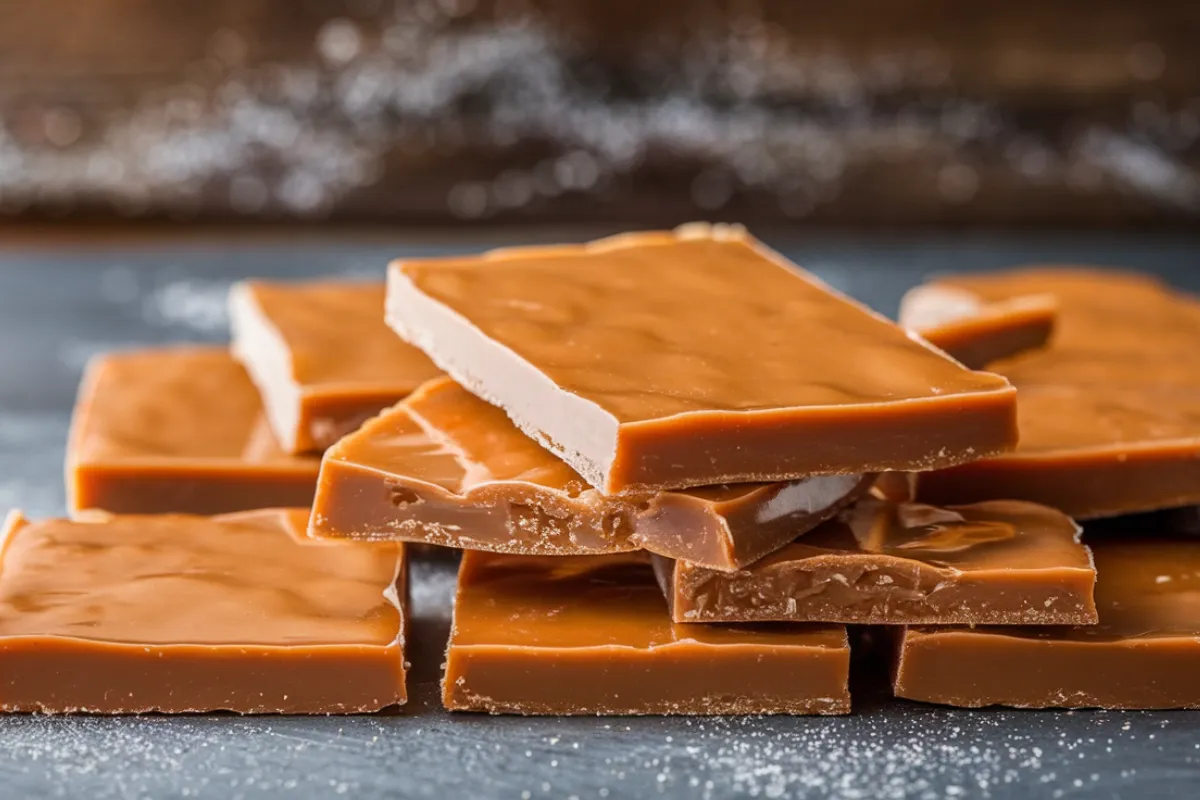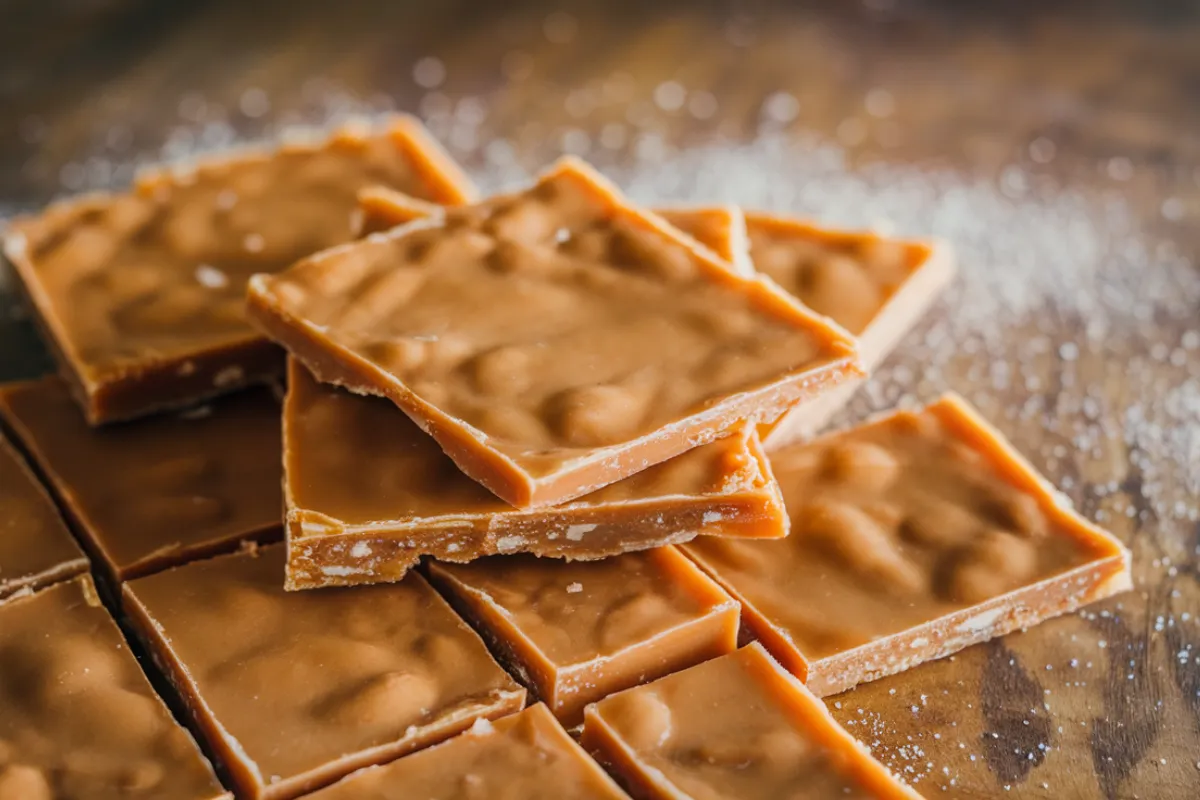Introduction
Toffee is a classic sweet that has delighted people for centuries. Known for its rich, buttery flavor and satisfying crunch, toffee comes in many forms, from a standalone treat to a key ingredient in delicious desserts. However, for those with food allergies, especially nut allergies, understanding what’s in toffee is very important. This article answers a crucial question for anyone concerned about allergens: Does toffee have peanuts? We’ll explore toffee’s ingredients, variations, and potential allergen risks, providing a complete guide to help you make safe choices when enjoying this beloved sweet.
What Is Toffee?
Definition and Basic Ingredients
Toffee is a type of sweet made from simple ingredients: sugar and butter. These two ingredients are heated together until the sugar caramelizes, creating toffee’s signature rich flavor. Once the mixture reaches the right temperature, it is poured onto a flat surface to cool and harden, resulting in a firm, brittle texture. Additional ingredients like salt and vanilla may enhance the flavor, but they aren’t necessary for the basic recipe.
Texture and Flavor
The texture of toffee can change depending on how it’s made. Some toffees are crisp and brittle, breaking with a satisfying snap, while others may have a slightly chewy consistency. The flavor is a perfect blend of buttery richness and caramelized sweetness. The cooking process makes these flavors even stronger, making toffee an indulgent and comforting treat. Depending on the recipe, toffee can also have flavors like chocolate, spices, or even liqueurs, offering a wide range of taste experiences.
Historical Background
The exact origins of toffee are a bit unclear, but many believe it started in England during the early 19th century. As sugar became more affordable, sweets like toffee became more popular among everyone. Over time, toffee evolved, with different regions and cultures adding their unique twists. From English toffee to American toffee, this sweet treat has a rich history that continues to grow today.
Common Ingredients in Toffee
Primary Ingredients
Every toffee recipe is built on a few key ingredients:

- Sugar: The main ingredient that gives toffee its caramelized flavor and structure.
- Butter: Adds richness and a smooth texture.
- Salt (optional): Balances the sweetness and enhances the overall flavor.
- Vanilla (optional): Adds a sweet aroma that complements the caramelized sugar.
These ingredients are mixed and heated to create toffee’s distinct taste and texture. While the basic recipe is simple, adding other elements can change the final product in significant ways.
Optional Ingredients
Many toffee recipes include extra ingredients to improve the flavor and texture:
- Chocolate: Often used as a topping, adding a creamy, rich layer that contrasts with the brittle toffee.
- Spices: Ingredients like cinnamon, nutmeg, or ginger can give the toffee a warm, spiced flavor.
- Flavor Extracts: Beyond vanilla, extracts like almond, coffee, or orange can introduce new flavors.
These optional ingredients allow for a wide range of flavor variations, making toffee a flexible sweet that you can adjust to your taste.
Inclusion of Nuts
Nuts are often added to toffee to give extra flavor and texture. Almonds, pecans, and walnuts are among the most commonly used nuts. These can be mixed into the toffee before it sets or sprinkled on top of a chocolate layer. While nuts are popular in toffee, they aren’t necessary, meaning you can make toffee without them if you prefer.
Does Toffee Contain Peanuts?
Variability in Recipes
Whether toffee contains peanuts depends on the specific recipe. Traditional toffee recipes don’t usually include peanuts, and peanuts are not a standard ingredient in most toffee preparations. However, some variations might use peanuts either as a main ingredient or as an optional addition. It’s important to know that peanuts are less common in toffee compared to other nuts like almonds or pecans.
Common Nuts Used
Almonds, hazelnuts, and pecans are the usual choices for nuts in toffee. These nuts have flavors that work well with the buttery, caramel notes of toffee. While some recipes might use peanuts, they are not as common because their strong flavor can sometimes overpower the more subtle sweetness of the toffee.
Peanuts in Commercial Toffees
When it comes to commercial toffee products, the presence of peanuts can vary. Some commercial toffees, like Heath Bars, use almonds and might be made in facilities that also handle peanuts. This can lead to cross-contamination, which is a concern for those with peanut allergies. Even if peanuts aren’t listed as an ingredient, there could still be trace amounts due to shared equipment, which is a critical issue for people with severe allergies.
Toffee Nut Flavor and Its Popularity
Toffee Nut Syrup
Beloved by coffee enthusiasts, the rich and nutty essence of toffee nut syrup has made it a popular choice in the coffee industry. It’s commonly found in lattes, frappuccinos, and other specialty drinks, adding a unique sweetness that many enjoy. This versatile flavoring has become a staple in cafes worldwide.
Comparison with Traditional Toffee
Traditional toffee and toffee nut syrup are quite different in both ingredients and use. Traditional toffee is a hard candy made from sugar and butter, often with added nuts or chocolate. Toffee nut syrup, on the other hand, is a liquid flavoring used to give a toffee-like sweetness and nutty flavor to drinks. The nutty flavor in toffee nut syrup usually comes from extracts or artificial flavorings, making it a different product from the solid, buttery texture of traditional toffee.
The Importance of Checking Labels for Allergens
Understanding Product Labels
For those with peanut allergies, knowing how to read and understand product labels is essential. Food labeling laws in many countries require companies to list all ingredients, including possible allergens like peanuts. When buying toffee or other sweets, it’s crucial to check the ingredient list carefully for any mention of peanuts or peanut-based products. Additionally, look for allergen warnings that mention whether the product was made in a facility that also handles peanuts.
Cross-Contamination Risks
Even if peanuts aren’t listed as an ingredient, cross-contamination can still occur. This happens when peanuts are processed in the same facility as other products, leading to trace amounts of peanuts being present in items that are otherwise peanut-free. For those with severe peanut allergies, this risk can be significant. Some companies use strict allergen control measures to reduce this risk, but it’s always a good idea to contact the company directly if you have any doubts about a product’s safety.
Homemade Toffee: Controlling Ingredients

Making Nut-Free Toffee at Home
Making toffee at home is one of the best ways to ensure it’s free from peanuts or other allergens. Homemade toffee gives you complete control over the ingredients, so you can avoid any unwanted elements. By following a simple recipe that uses only sugar, butter, and optional flavorings like vanilla, you can create a delicious, nut-free toffee that’s safe for those with allergies.
Substitutions and Alternatives
If you enjoy the texture and flavor of nuts in toffee but need to avoid peanuts, there are plenty of alternatives:
- Sunflower Seeds: These seeds offer a similar crunch to nuts without the risk of peanut exposure.
- Pumpkin Seeds: Another nut-free option that adds both texture and flavor to toffee.
- Dried Fruits: Chopped dried fruits like cranberries, apricots, or raisins can add a chewy contrast to the brittle toffee, offering a delightful variation.
These substitutions allow you to get creative in the kitchen while keeping the final product safe for those with peanut allergies. By experimenting with different ingredients, you can make a unique toffee that fits your taste and dietary needs.
FAQs
Does toffee always contain nuts?
No, toffee doesn’t always contain nuts. While nuts like almonds or pecans are often added for texture and flavor, they aren’t necessary for the basic toffee recipe. You can easily make nut-free toffee by leaving out the nuts.
Can I make toffee without any nuts?
Yes, you can make toffee without any nuts. The traditional recipe only requires sugar, butter, and optional flavorings like vanilla. You can leave out the nuts if you prefer or need to avoid them due to allergies.
Are there commercial toffees that are peanut-free?
Yes, there are commercial toffees that are peanut-free. However, it’s important to read labels carefully and be aware of potential cross-contamination in facilities that process both peanut-containing and peanut-free products. Look for brands that specifically label their products as peanut-free and those that take extra precautions to prevent cross-contamination.
What should I look for on labels to avoid peanuts in toffee?
When checking labels, look for clear mentions of peanuts in the ingredient list. Also, watch for allergen warnings about peanuts or cross-contamination risks. If you’re unsure, contact the manufacturer for more details. Always be cautious if you have a severe allergy.
What is the difference between toffee and toffee nut?
Traditional toffee is a hard candy made from sugar and butter, sometimes with added nuts like almonds. Toffee nut usually refers to a syrup flavor used in drinks, combining toffee’s sweetness with a nutty flavor, often from hazelnuts or almonds. Unlike traditional toffee, toffee nut syrup doesn’t contain solid toffee or nuts, making it a different product used mainly for flavoring.
Conclusion
In conclusion, while toffee is a versatile and delicious treat, it’s crucial to be aware of its ingredients, especially for those with peanut allergies. Traditional toffee doesn’t usually contain peanuts, but some variations and commercial products might include them or pose a risk of cross-contamination. If you love toffee but need to avoid peanuts, making homemade toffee with carefully chosen ingredients is a great option. By staying informed and reading labels carefully, you can enjoy toffee safely.
For more recipes and information on safe, allergen-free cooking, visit our homepage.


1 thought on “Does Toffee Have Peanuts? Understanding Ingredients for Nut Allergies”